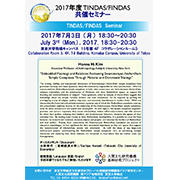2017年度 TINDAS-FINDAS 共催セミナー
2017-7-3(月) 18:30-20:30開催
| 日時 | 2017年7月3日(月)18:30~20:30 |
|---|---|
| 会場 | 東京大学駒場キャンパス 18号館 4F コラボレーションルーム3
東京大学アクセスマップ |
| 報告者 | ◆Hanna H. Kim
(Associate Professor of Anthropology, Adelphi University) |
| 報告タイトル | "Embedded Meanings and Relations: Reckoning Swaminarayan Akshardham Temple Complexes Through Material and Devotional Tracings" |
| 要旨 | The striking visibility and monumental dimensions of Swaminarayan Akshardham temple complexes have provoked curiosity and raised questions about the community responsible for their construction. Who has constructed the Akshardham temple complexes in India; what connections are there between Akshardham, religious nationalism, and the globalisation of Hinduism; why does Akshardham appear to support the branding and commodification of religion? These questions, asked by analysts of Akshardham, suggest that knowledge about the temple complex builders and their motivations can be acquired by probing the overlapping arenas of religion, politics, migration, and economic liberalisation in modern India. While not discounting the historical and political economic contexts out of which the Akshardham complexes emerge, this presentation explicitly focuses on the materiality of the Swaminarayan Akshardham temple complexes: what do these architectural and spatial sites accomplish? As built objects, the temple complexes engender, provoke, and nurture responses; they create relationships, initiate self-transformations, and offer avenues by which their publics, including their builders and Swaminarayan followers, interpret the spaces of their everyday lives. By looking more closely at what Akshardham accomplishes, it is possible to trace the links between the material and relational, between objects and peoples, and between the builders of Akshardham and their publics. Tracing these connections, the Swaminarayan Akshardham complexes are sources of discursive assemblages, no less significant for their devotional importance as they are spaces that support the materialisation of relationships, power, and sentiments. As with the story of any large-scale architectural project, understanding the Akshardham temple complexes rests on connecting multiple discourses and exploring how these relations are enmeshed in materialities that are neither static nor homogeneous. |
| ディスカッサント | 小牧幸代 (高崎経済大学) |
| 使用言語 | 英語 |
| 備考 | 予約不要 |
| お問い合わせ先 | findas_office[at]tufs.ac.jp(鈴木)
※[at]を@にかえて送信してください。 |
ポスター
 | |
